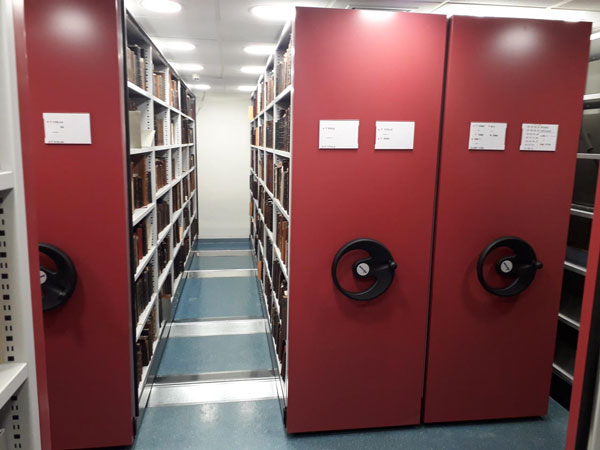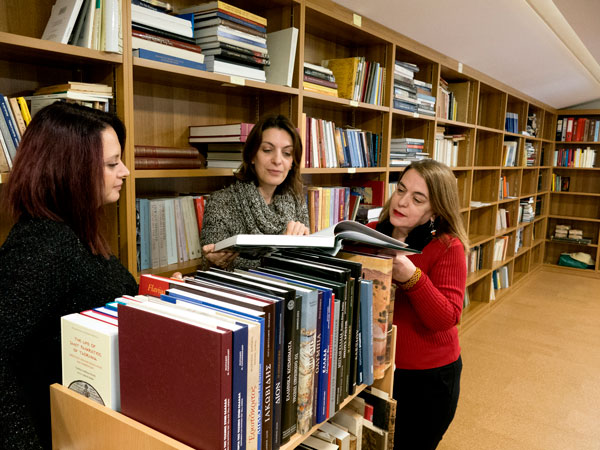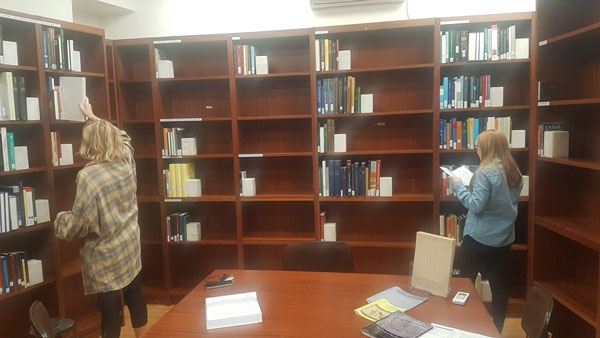
Modernizing the Libraries: Q&A with Librarians Maria Tourna and Irini Solomonidi
The Library Reclassification Project to integrate, customize, and modernize the classification systems of the Blegen and Gennadius Libraries will improve the experience of the thousands of international patrons who use them each year.
This project is generously funded by grants from the Stavros Niarchos, Andrew W. Mellon, and Horace H. Goldsmith Foundations, and is coordinated by Maria Georgopoulou, Director of the Gennadius Library.
In this Q&A, Head Librarian Maria Tourna of the Blegen and Senior Librarian Irini Solomonidi of the Gennadius explain what this change means for each of the libraries.
*For the most up-to-date information on the project’s progress, including important details about closures, please visit: www.ascsa.edu.gr/news/newsDetails/reclassification-project or the Blegen and Gennadius Facebook pages.
ASCSA: What are the objectives and time frame of the Library Reclassification Project?
MT: The project will convert all of the libraries’ research holdings from their outdated local classification systems to the more sophisticated and universal Library of Congress (LC) Classification System. In conjunction with this conversion, all of the volumes (except for rare books and offprints) have been equipped with radio-frequency identification (RFID) tags for improved inventory, faster searching, and greater security.
Phase I of the project, which began in September 2017, involved the physical tagging and remote classification of the 250,000-plus volumes in the combined collections. The RFID portion is complete, while the data conversion continues at a careful yet timely pace. Phase II, the physical shifting of the collections, will require the libraries to close for consecutive periods. The Blegen will close in late February or early March 2019 and reopen in June, while the Gennadius will close as soon as the Blegen reopens, with plans to open its doors again in August.
IS: At the Gennadius Library, there was also a second project, which ran simultaneously: an inventory of all of the rare materials (which were not tagged with RFID or reclassified to align with the Library of Congress system.) The project started in 2015 and was completed in December 2017. A total of 40,000 rare titles were identified and transferred to the new Special Collections unit in the Gennadius Library, separate from the research resources.

ASCSA: Why is now the time to make this change?
MT: The School has been discussing the possibility of converting to the Library of Congress (LC) Classification System for years. Even from the time I came in 2000, the staff knew that the change would need to be made at some point. Now seemed like the perfect time because the funding opportunity presented itself, and this way the reclassification could be done in conjunction with other components like RFID tagging and transferring the Archives to Special Collections—all to coincide with the renovation of the Gennadius Library’s Makriyannis Wing.
ASCSA: What was the impetus to change the old system?
MT: The Blegen’s local system was established in 1903, and has since served the library well— but it has its limits in that there are no diagrams for expansion for most of its sections. Like LC, it uses letters to indicate the classification, but the meaning of those letters is not consistent, and the call numbers are based on different criteria from class to class.
Since nobody could predict back then how the trends in scholarship would develop, we reached the point where certain subject areas ran out of call numbers. In these cases, we have to assign numbers that place new books several titles away from their group, or reclassify the whole set. Both of these approaches can be time-consuming for librarians and confusing for users. The system has been well maintained and the librarians have been able to adapt, but going back to fix and correct things as each subdivision reaches its limits is not a sustainable option.
One inconsistency of the old system is presented by changes in political geography: since it was always suggested to keep classification changes to the minimum, countries, such as the former USSR and the former Yugoslavia, are still classified under their old names.
Additionally, the old system was not guided by any real rule, and information about how to classify has, for the most part, been passed down orally from one generation of librarians to the next, with very little recorded except Camilla MacKay’s 2003 article explaining the history of the system (http://www.ascsa.edu.gr/pdf/uploads/MacKay.pdf).
IS: The Gennadius Library used an idiosyncratic, closed system of classification developed by John Gennadius for his personal library before it was acquired by the School in 1926. This local system cannot be expanded and often cannot accommodate new acquisitions in current fields of research, especially when they fall outside the original holdings. While the research collection will be converted to Library of Congress, the original classification system will be maintained for the library’s 40,000 rare titles, comprising the core of the library’s initial holdings as donated by John Gennadius.
ASCSA: Why was LC chosen as the new system?
MT: LC is a universal, widely-used system that is updated regularly with any new discipline that emerges, and provides space for divisions, subdivisions, and classes of any new trend. It will allow us to build and utilize the collection in ways that bring the library into the 21stcentury.
Most importantly, we have complete control over how to customize the database and tailor it to our users, i.e. we don’t necessarily have to follow the LC way of classifying things if it doesn’t make sense for our library. On the other hand, there might be material that fits better in the LC subdivisions than in our own customized system. This a great benefit and the main reason we are so confident in going ahead with it. The goal in this library is to use the LC system to better organize the collection, taking into account all of its specialties, and to classify the material in a way that meets the needs of our users.
Even though LC is not used in many libraries in Greece, the fact that the Universities of Thessaloniki and Crete have been using it for years is a great advantage. Consulting them when necessary and checking their catalogs has been really helpful.
IS: Another supplementary reason for choosing Library of Congress is that both libraries follow the Anglo-American rules for cataloguing, as well as Library of Congress subject and name headings, already. So applying LC call numbers is in compliance with the cataloguing practices already in place.
ASCSA: How will the new system improve the library experience for the users?
MT: Because there will be universal schemes to follow, anyone can learn it now; new users will no longer need to be initiated to the idiosyncracies of the old system. On the contrary, they will be introduced to the guiding philosophy of the new system and its clearly laid out subdivisions. And, as we discussed before, the librarians’s efforts will be for the new numbers to make sense—so that books can be classified, wherever possible, in the subject areas where our particular users expect to find them. This will make all aspects of the research process easier.
ASCSA: How will the new system allow the staff to better care for the collection?
MT: The standards behind the new system allow each of us to have more authority as cataloguers. All of the librarians from both libraries have taken courses on the Library of Congress system, and are subscribed to resources that will serve as permanent tools for helping us catalogue and manage the collection. These elements will allow us to spend less time classifying and more time building and fine-tuning the collection.
IS: As it concerns the Gennadius Library, adopting LC and training our librarians in it will give them the time and the opportunity to better care for the rare collections, and to highlight items within them through seminars and exhibitions. The Gennadeion will be better able to realize its dual strength as a special collections library and as a research library; this is really important.

ASCSA: What has been the biggest challenge in the transition process so far?
MT: One of the biggest challenges for us so far has been to go through our collection to decide which material we want see grouped together as it is currently, regardless of where the LC system would have it placed (when Irini and I visited the Academy in Rome to discuss their 2015 conversion to LC, they emphasized the importance of taking this step in advance of the process).
For instance, we want our excavation series assigned by site (e.g. “Agora”), as opposed to subject (e.g. “Sculpture”), and our ancient authors in their own section as opposed to their discipline (e.g. works by Aristotle under “Ancient Authors” as opposed to “Philosophy”). This is the way our users prefer, so that’s what we are doing.
Library Solutions, the LC company we are working with for Phase I of the project, began the process of going into Aleph, our Library Management system, and assigning numbers remotely based on our preferences, and now Irini and I are continuing it by directing our cataloguers and the Library Project Assistant (who serves both libraries) in assigning the rest of the numbers.
Another challenge will come afterwards, with the physical shifting of the collection. We are picturing how the shelves will be organized on the floors and we are already working very closely with Backstage, the company responsible for the move.
IS: Also, reclassifying from the local system to the LC system often disperses the books toward different ranges of call numbers ("different places"). A challenge for us is deciding how to keep subjects together.

ASCSA: How will the physical space of the library change?
MT: The Rare Book Room was completely remodeled from August to September 2018, following the transfer of the rare books to their new home in the Gennadius (to be consolidated with Special Collections). The updated Rare Book Room now houses all of the new books—those acquired since July, as well as future incoming titles—all of which are being given LC call numbers and shelved there until the library closes. Remodeling of the former Archives area below the ground floor, which also began in August, is nearly complete; there is now a lot more space for book stacks and work areas, including new tables and member carrels.
A smaller physical change will be the presence of checkout kiosks throughout the library. These kiosks, which can identify and check out a pile of books in a single scan, will also allow users to find books faster and to check out titles online. Additionally, librarians will be able to gather better statistics about how the collection is used. This change is brought about by the system’s conversion to RFID, completed last year (all books, with the exception of rare books and offprints, have been tagged, and a sensor gate was placed at the library exit in December 2017.) Since the School never barcoded its books, we are able to transition straight from sign-out cards to this much more technologically advanced solution.

ASCSA: What are some alternative research options for our users while the Blegen and Gennadius Libraries are closed?
MT: We have communicated our plans for closure with all of the archaeological libraries of the foreign schools, research libraries (such as the Archaeological Society of Athens) and institutions (such as the University of Athens), in the city via a network system. All of these libraries, especially that of our next-door neighbor the British School, will remain open and available to American School students and scholars.
IS:Also, a good option for the Gennadius Library readers would be to use the National Library of Greece.
ASCSA: Once the library reopens, what do you think will be the biggest challenge?
MT: Assisting users through this transitional period by introducing them to the new system is the biggest challenge. Keep in mind that most of them, especially the Greek and European scholars, are not familiar with this classification system, so we will do our best—through online tutorials, printed signs, and in-person orientations—to guide them in the right direction. The kiosks will also be something to get used to, and we will be there to help our patrons through that transition, as well.
So, short term, the challenge will be orientation of the new system; long-term, the focus is on developing the collection most efficiently for the future.
IS: Our biggest challenge is training οur readers on how to use all of the new features: the open stacks, the new classification system, and the kiosks. But judging from how easily our readers started using the AMBROSIA online catalog in 2005 (when up until then they had only used the card catalog), we are very optimistic.
ASCSA: Do you have any additional thoughts to share?
MT: Our users are very important to us, and so is the collection. Many of our patrons have been using this library for decades and are extremely familiar with it; we know what it means to those who travel the world to use it. The collection itself is unparalleled, and we are here to make sure it maintains its special character and nuanced qualities through this transition period and into the future.
IS: The major changes in the structure and operations of the School’s libraries make it possible for the services provided to the users to be improved, and enable the libraries to operate in a more harmonized, consolidated manner. These changes also give the Gennadius Library the opportunity to separate out its rare materials, emphasizing its mission as a library/museum of rare collections related to the history of Hellenism, according to the vision of John Gennadius.